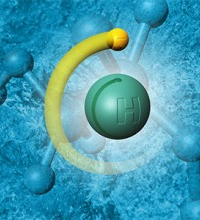Cobalt Gets the Job Done
Catalyst produces hydrogen through steam reforming of biomass-derived ethylene glycol
(April 2016)

A recent study combined experimental and theoretical approaches to compare the hydrogen yield achieved by several different metal catalysts used for steam reforming ethylene glycol.
Hydrogen production through steam reforming biomass-derived compounds is an economically feasible and environmentally benign way to efficiently use renewable energy resources. A study by scientists at Pacific Northwest National Laboratory compared the hydrogen yield achieved by several different metal catalysts used for steam reforming ethylene glycol. The findings show a cobalt catalyst had a much higher hydrogen yield than rhodium or nickel catalysts, making it a promising catalyst for steam reforming ethylene glycol for hydrogen production.
Why It Matters: Ethylene glycol is found in aqueous phases that are produced from the direct liquefaction of plant-derived cellulose or cellulosic oxygenates. The study could lead to the development of more efficient strategies to produce hydrogen from bio-derived aqueous phases as an environmentally friendly strategy to power diverse energy needs.
Methods: Steam reforming biomass-derived compounds is a promising strategy for hydrogen production. To realize the full potential of this approach, scientists must identify which catalyst is optimal for producing the highest yield of hydrogen. To address this question, a team of researchers from Pacific Northwest National Laboratory combined experimental and theoretical methods to study steam reforming ethylene glycol over MgAl2O4-supported rhodium, nickel, and cobalt catalysts.
Computational work and advanced catalyst characterization were performed at EMSL, the Environmental Molecular Sciences Laboratory, a DOE national scientific user facility.
Compared to the highly active rhodium and nickel catalysts which achieve 100 percent conversion of ethylene glycol, the steam reforming activity of the cobalt catalyst was comparatively lower, with only 42 percent conversion under the same reaction conditions. However, the use of the cobalt catalyst rather than the rhodium and nickel catalysts resulted in a three-fold drop in methane selectivity-a measure of the percentage of ethylene glycol converted to methane. Calculations revealed the lower methane selectivity for the cobalt catalyst, as compared to the two other catalysts, is primarily due to the higher barrier for methane formation.
The findings demonstrate that the cobalt catalyst leads to a higher yield of hydrogen, at the expense of methane, compared to the other two. Additionally, the cobalt catalyst was also found to offer enhanced catalyst stability compared with the more conventional nickel and rhodium catalysts.
What's Next? This information could be used to develop efficient methods for converting biomass-derived compounds into hydrogen for petroleum refining, the production of industrial commodities such as fertilizers, and electricity production via fuel cells.
Acknowledgments
Sponsor: U.S. Department of Energy (DOE)'s Bioenergy Technologies Office.
Research Area: Chemical Sciences
User Facilities: Computing time and advanced catalyst characterization use was granted by a user proposal at EMSL, a national scientific user facility sponsored by DOE Office of Science's Office of Biological and Environmental Research and located at PNNL. This research also used resources of the National Energy Research Scientific Computing Center, a DOE Office of Science user facility.
Research Team: Donghai Mei, Vanessa Lebarbier Dagle, Rong Xing, Karl O. Albrecht, and Robert A. Dagle, Pacific Northwest National Laboratory
Reference: Mei D, VL Dagle, R Xing, KO Albrecht, and RA Dagle. 2016. "Steam Reforming of Ethylene Glycol over MgAl2O4 Supported Rh, Ni, and Co Catalysts." ACS Catalysis 6(1):315-325. DOI: 10.1021/acscatal.5b01666
This article first appeared on the EMSL website; see "From Biomass to Hydrogen."
